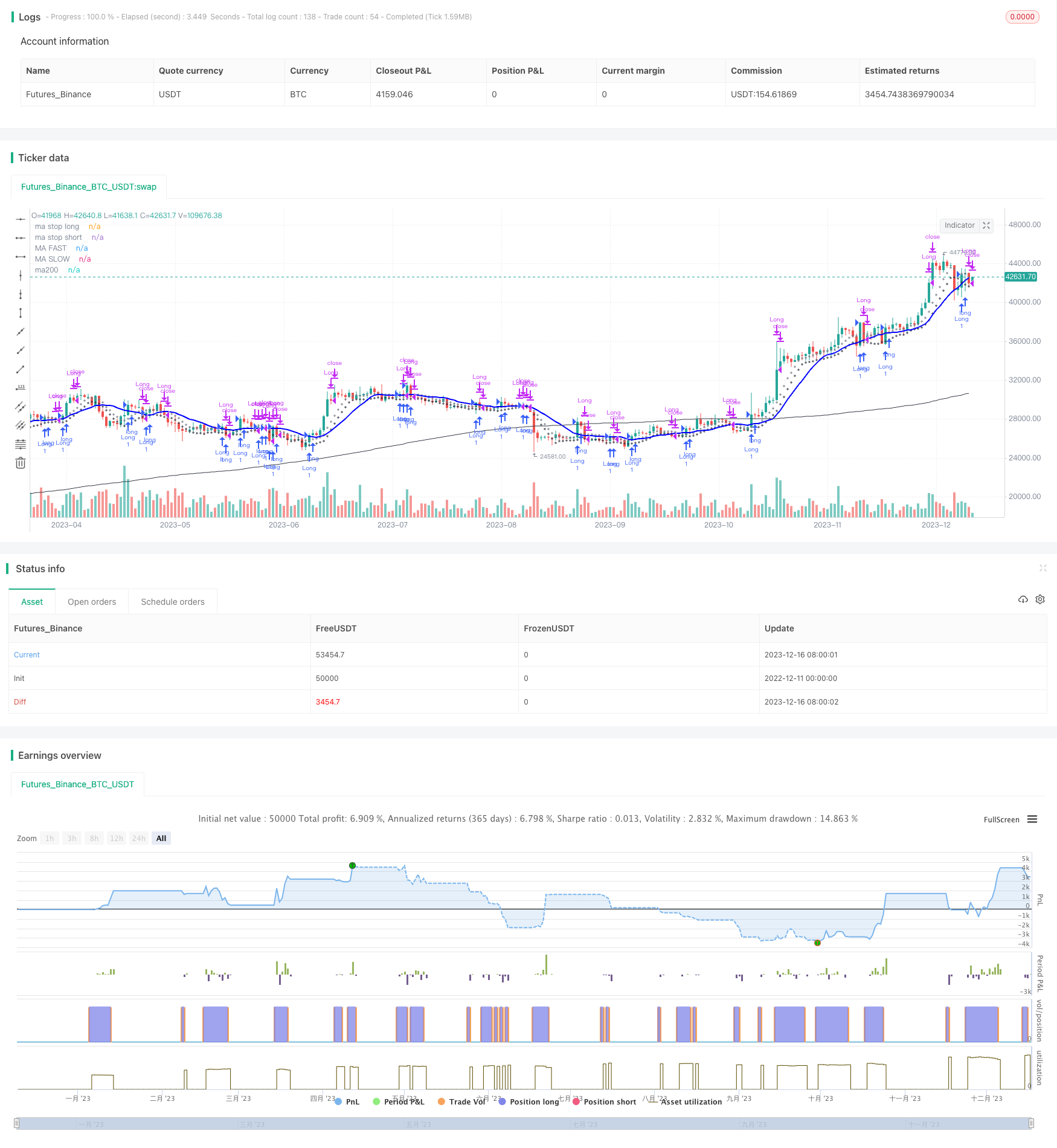La stratégie SMA et RSI à long terme
Auteur:ChaoZhang est là., Date: 2023-12-18 10:28:10 Je vous en prie.Les étiquettes:

Résumé
Cette stratégie est adaptée des articles d'Enrico Malverti. Elle utilise principalement la moyenne mobile simple (SMA) et l'indice de force relative (RSI) pour identifier les signaux d'entrée et de sortie longs.
La logique de la stratégie
Le signal d'entrée est déclenché lorsque le prix de clôture franchit la ligne SMA à plus longue période.
Les signaux de sortie comprennent:
- Fermer long lorsque le RSI dépasse 70 ou dépasse 75;
- Le prix de clôture de l'opération est supérieur à la ligne SMA de la période plus courte.
- Profitez lorsque le prix de clôture dépasse la ligne SMA de la période courte.
La ligne SMA stop loss et la ligne SMA take profit sont également tracées.
Analyse des avantages
Les avantages de cette stratégie:
- Utilise une combinaison d'indicateurs simple et facile à comprendre;
- Il ne s' agit que de longs pour éviter le risque de vente à découvert;
- Il a des règles claires en matière d'entrée, de stop loss et de prise de bénéfices, un risque contrôlable;
- Facile à optimiser en ajustant les périodes SMA, etc.
Analyse des risques
Il y a des risques:
- Le biais psychologique de perdre confiance après une défaite.
- Le décalage de la ligne SMA peut entraîner des risques;
- Les signaux de divergence RSI peuvent être peu fiables.
Les solutions:
- Mettre en place un mécanisme de négociation fixe suivant des règles;
- Optimiser les périodes SMA;
- Ajouter d'autres filtres pour les signaux RSI.
Directions d'optimisation
La stratégie peut être encore optimisée:
- Test de différents paramètres pour la SMA;
- Ajouter d'autres indicateurs à titre de filtres;
- Ajouter une identification de tendance pour distinguer tendance et consolidation;
- Adaptation et optimisation des paramètres.
Conclusion
L'idée générale est simple et claire. Avec des indicateurs de base et une maîtrisabilité, il convient au trading à moyen et long terme. Mais le réglage des paramètres et le filtrage des indicateurs nécessitent beaucoup de tests et d'optimisation pour rendre la stratégie plus solide et fiable. Des idées simples nécessitent d'énormes efforts d'optimisation et de combinaison pour former de vrais systèmes de trading utilisables.
/*backtest
start: 2022-12-11 00:00:00
end: 2023-12-17 00:00:00
period: 1d
basePeriod: 1h
exchanges: [{"eid":"Futures_Binance","currency":"BTC_USDT"}]
*/
//@version= 4
// form the original idea of Enrico Malverti www.enricomalverti.com , trading system 2015
// https://sauciusfinance.altervista.org
strategy(title="MAs & RSI strategy long only", overlay = true, max_bars_back=500)
///********FROM EMAS TO SIMPLE MA *****
// NON AGGIUNTO SCHAFF INDICATOR, che serve per discriminare quali titoli scegliere dallo screener (segnale già aperto o il primo o, a parità,
//quello più alto) ==> Tolte le bande di Bollinger (che filtrano "poco")
// INPUTS
emapf = input(14, title ="Ma periodo veloce", minval=1, step = 1)
emapl = input(14, title ="Ma periodo lungo", minval=1, step = 1)
emaps = input(7, title ="Ma periodi stop", minval=1, step = 1)
rsi_period = input(14, title="RSI period", minval = 1, step = 1)
// CALCULATIONS
maf = sma(close, emapf)
mal = sma(close, emapl)
// rsi
myrsi = rsi(close, rsi_period)
//ema stop long ed ema stop short
//Ema7 messo da "massimo" a "chiusura" come target per posizioni short. Il limite è, in questo caso, sempre ema20 (più restringente - asimmetria)
// in questo t.s., lo short viene soltanto indicato come "rappresentazione grafica", non agito
mass = sma(close, emaps)
masl = sma(low, emaps)
ma200=sma(close,200)
/// Entry
strategy.entry("Long", true, when = crossover(close,mal))
rsi1 = crossunder(myrsi,70)
rsi2 = myrsi > 75
// previously, 80
st_loss_long = crossunder(close,masl)// **chiusura sotto EMA7**
target_long= crossunder(close,maf) //* Chiusura sotto EMA14*
// exits. *RSI**Long: Target if over bandamax, loss if under bandamin. Viceversa, for short
strategy.close("Long", when = rsi1, comment="crossunder RSI")
strategy.close("Long", when = rsi2, comment ="RSI MAX")
strategy.close("Long", when = st_loss_long, comment = "Stop loss")
strategy.close("Long", when = target_long, comment = "target_long" )
plot(masl, title="ma stop long", color=#363A45, linewidth= 1, style=plot.style_cross)
plot(maf, title="MA FAST", color=#FF0000, linewidth= 1)
plot(mal, title="MA SLOW", color=#0000FF, linewidth= 2)
plot(mass, title="ma stop short", color=#787B86,linewidth= 1, style=plot.style_cross)
plot(ma200, title="ma200", color=color.black, linewidth= 1)
- La stratégie de croisement des moyennes mobiles de Galilée
- Stratégie de contre-essai AC de l'indicateur Williams
- Achat directionnel à faible volatilité avec prise de profit et stop loss
- Stratégie d'arrêt des pertes et de prise de bénéfices à pourcentage fixe basée sur des moyennes mobiles
- Stratégie de négociation quantitative basée sur la double EMA et l'indice de volatilité des prix
- Stratégie de suivi bidirectionnelle de la rupture de l'élan
- Super Trend LSMA stratégie à long terme
- Stratégie d'inversion de la rupture de trois barres et de quatre barres
- Stratégie de négociation ergodic adaptative SMI basée sur des moyennes mobiles exponentielles adaptatives
- Stratégie SMA et PSAR pour les opérations au comptant
- Stratégie de rupture de la moyenne mobile à double inversion
- Stratégie de suivi de tendance basée sur le Cloud Ichimoku
- Stratégie de négociation à haute fréquence basée sur les bandes de Bollinger et les indicateurs StochRSI
- Stratégie d'équilibre à double inversion
- Stratégie de SMA de renversement de la moyenne HYE
- Stratégie de renversement de la moyenne mobile double
- Stratégie de négociation en temps réel de la percée des prix dans les deux directions
- Stratégie boursière de rupture de Bollinger
- Stratégie de percée de l'oscillation à sept bougies
- Stratégie de suivi des tendances de Golden Dead Cross